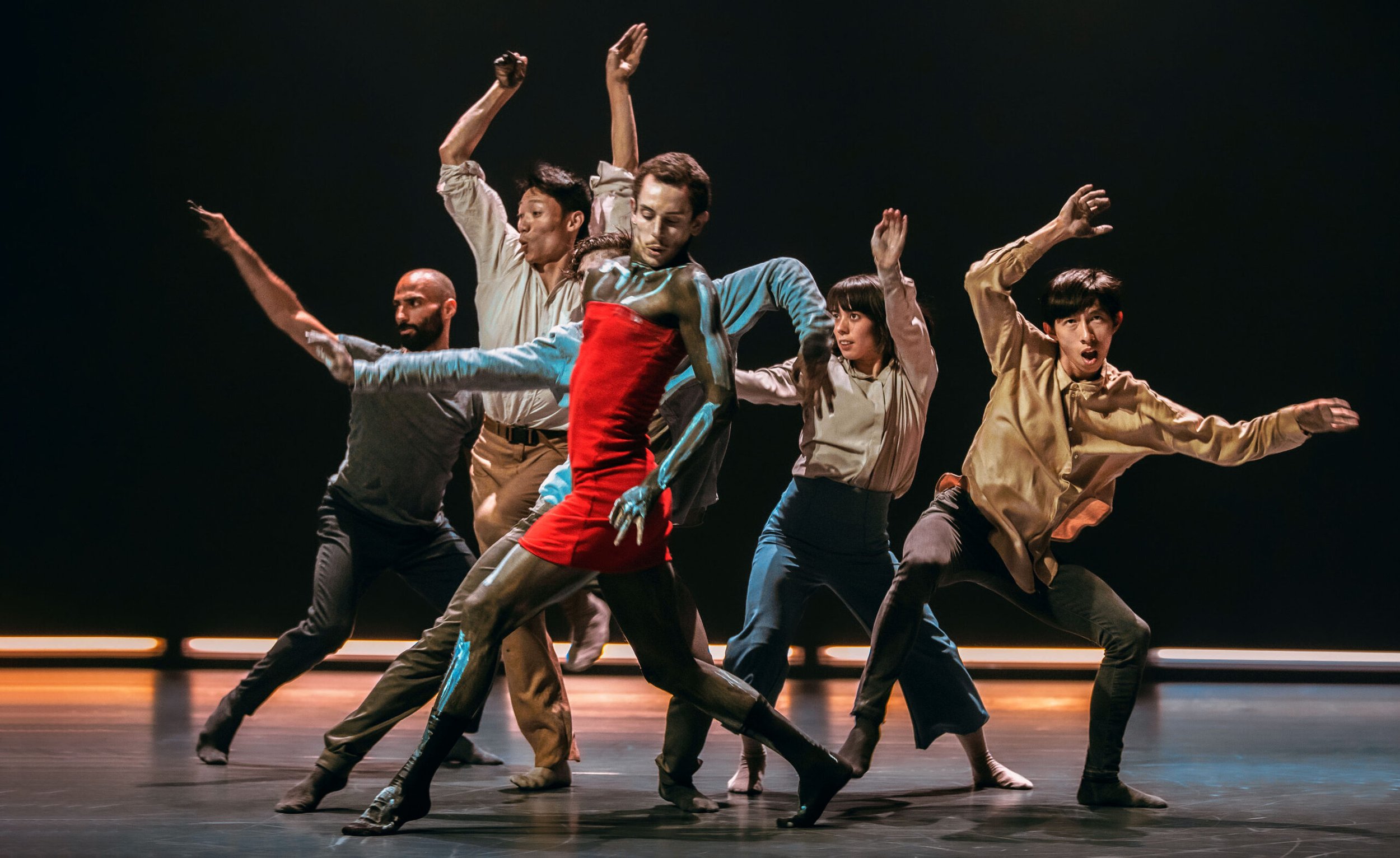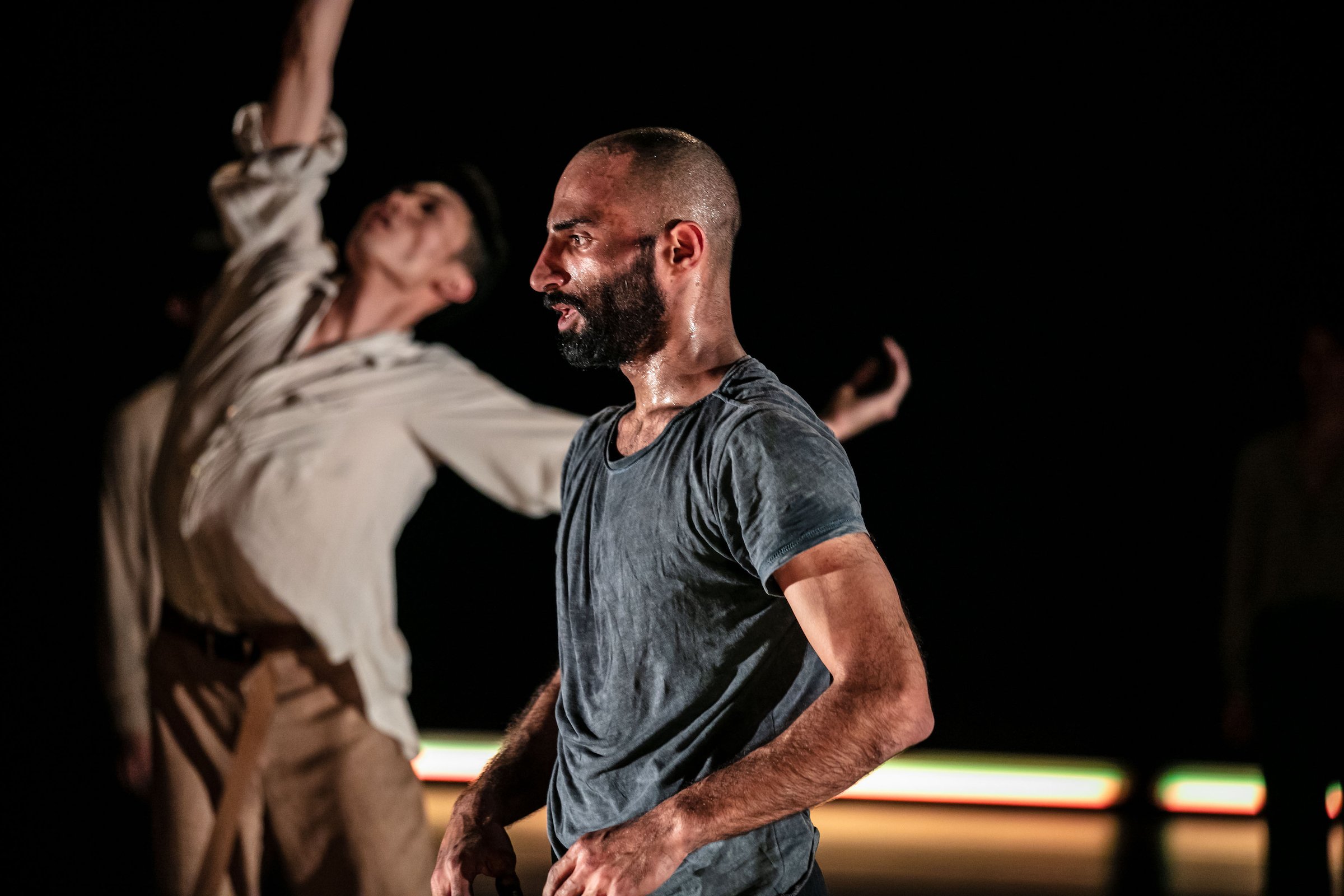With Story, story, die., Norway's winter guests explore the narratives we create about ourselves
Fast-rising Norwegian choreographer Alan Lucien Øyen mixes dance and theatre in new, subversive ways
Fragmented stories and surreal touches define Story, story, die. Photo by Mats-Bäcker
DanceHouse presents winter guests’ Story, story, die at the Vancouver Playhouse on June 22 and 23
“STORY, STORY, DIE.” THAT’S the name of an elimination game where players sit in a circle and one of them starts telling a story. At any time—even mid-sentence—the person running the game can point to another player who has to pick up where the story left off. If they stumble or hesitate, everyone yells “DIE!” and that player is kicked out of the game.
Fast-rising Norwegian dance-theatre artist Alan Lucien Øyen sees the game as a grand metaphor for life today—for the instant, likable narratives, or possibly lies, we’re forced to create around ourselves, and especially the speed with which we’re forced to do so on social media. We’re under constant scrutiny and pressure to like and be liked—to come up with attractive, Instagrammable narratives for ourselves, or “die”.
That’s why Øyen used the name of the game as the title for the latest creation by his company winter guests—a poignant, slightly surreal and text-driven piece that travels here to close DanceHouse’s season.
“We didn't set out to make a social-media piece,” the genial, thoughtful choreographer stresses to Stir over a Zoom call from Ottawa, where winter guests perform before heading here. “I just find that social media is the strongest articulation of that phenomenon: the staging of the reality for the benefit of others or yourself—the idea that if it didn't happen ‘onstage’ then it didn't happen at all.
“I think it’s the same thing in real life: when you meet people and you omit things or you highlight things through conversation,” he continues. “It’s just that the internet, along with all the wonderful things it does for us, has gone rogue. It’s a runaway situation.”
It’s fitting that Øyen should be so interested in the ways we tell stories about ourselves; storytelling and text are very much at the root of his signature creations—which span theatre and dance, and the interdisciplinary space between them.
“I think it's because I wanted to do both dance and theatre [growing up], and I kind of ended up doing them at the same time,” he says. “My work is rarely just dance—almost always there’s words with the movement.
“I keep saying for me they're the same thing,” he continues, comparing dance and theatre. “There’s the event onstage, a person in a room communicating: either they manage to or they don't. Either I believe them or I don't. For both it's the same: I'm looking for a frailty in a way that I can recognize, something universal in a way—which sounds high falutin’ in a way. But it’s not! I'm just looking for someone to recognize: human beings being human beings .”
Øyen’s unique approach has a lot to do with his upbringing, and his route to the stage. The Bergen-raised son of a stage dresser, he grew up surrounded by the world of theatre, but turned to dance at 17, eventually performing for the likes of Norway’s celebrated Carte Blanche and Amanda Miller’s Pretty Ugly. Øyen went on to found his own company winter guests in 2006, often creating plays with British theatre artist Andrew Wale under its name.
He’s gone on to become resident choreographer with the Norwegian National Opera and Ballet—regularly staging works in Oslo’s architecturally stunning Norwegian Opera House—and has created pieces for companies from the Paris Opera Ballet to Staatsoper Berlin.
Choreographer Alan Lucien Øyen.
The most buzz has surrounded his work with the world-renowned Tanztheater Wuppertal Pina Bausch, where he (along with Greece’s Dmitris Papaioannou) was chosen to become one of the first artists to choreograph new work for the company since the legendary Bausch’s death in 2009.
To create Story, story, die., Øyen took inspiration from the performers’ real-life experience, as he so often does. The work started with open conversations with the dancers—and many of the looping fragments you’ll hear them speak in the production (“How’s your life going?” “Are you happy with it?” “But let’s be honest…” “What are the chances?”) are drawn directly from those sessions.
The choreographer likes to ground his works in that raw authenticity, but then upends, deconstructs, or alters it in surreal, and cleverly meta, ways. In the case of Story, story, die., the fragmented lines of speech become staggered, a door on the stage literally opening and slamming on each narrative bit. Some of his touches verge on the dreamlike: an unsettling teddy bear and a figure in skeleton paint and a red-bustier dress. (Though their movement languages are markedly different, critics have compared his use of and physicalization of spoken text to Crystal Pite.)
“With dance, I might spend the whole day talking to the dancers because… Well, I want to procrastinate, probably, sure!” the choreographer says with a laugh. “But I need to know the people I’m creating with in order to create, and then from the exchange with them we find the relevant questions and what kinds of answers we’re interested in pursuing,” he explains. “When I go through things afterwards, there is a lot of kind of tweaking and writing I do myself, all based on fragments of dialogue or sometimes of other text. Most often it's subverted in some way, where I play devil's advocate.
“There's a lot of that framing,” he elaborates. “But I guess I’m just looking at what’s triggered in my head from conversations with others. It feels like having a big brain where a lot of people are working and thinking. But because it came from the dancer, it’s also echoed back to them so it’s also their own thought or idea—at its best it gives them ownership of what they created.”
Vancouver audiences should understand that as much as Øyen plays with words, his movement is as physical and hyperdetailed as it comes: twisting, spiralling, and collapsing. In Story, story, die., that also comes with the breathless speed he likens to the infinite scrolling of your chosen social-media feed.
“It’s just that I work a lot of meaning behind movement; so even if it looks abstract on the surface, I’m kind of determined that when we make a choreography, whether it's crafted by me or the dancer, it’s from content—text or words," he explains. "They know what they're saying.” And so, clearly, does this exciting voice in the world of contemporary dance-theatre.
Story, story, die. Photo by Mats-Bäcker















